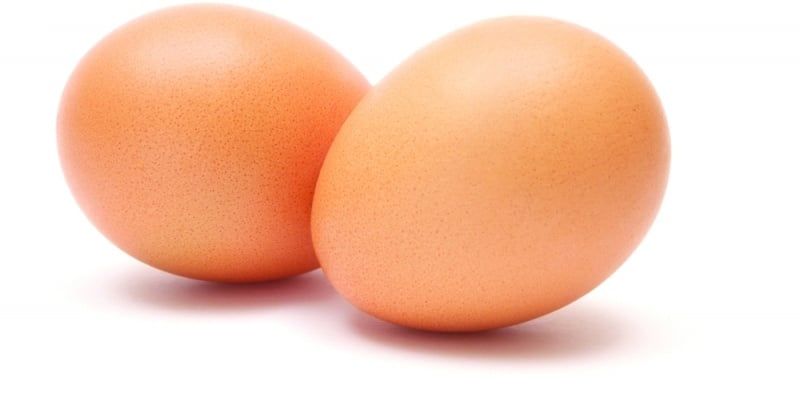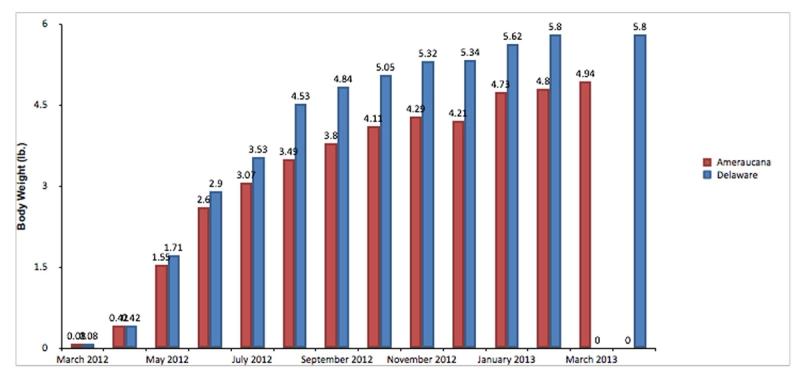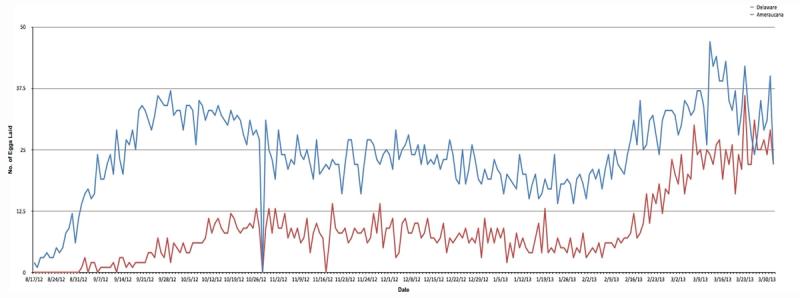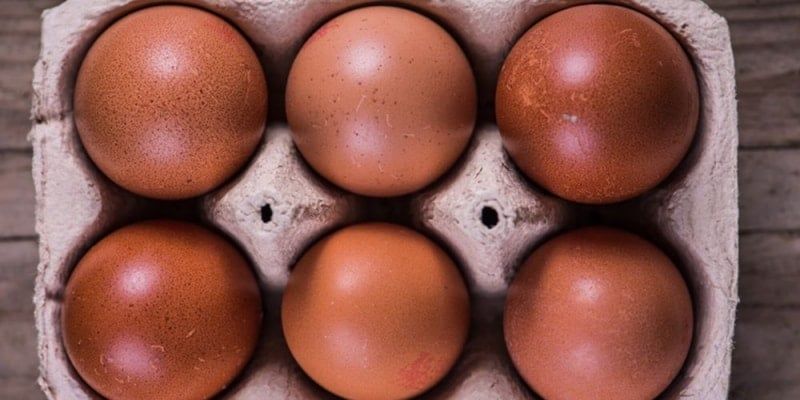Pastured Egg Performance: Delaware vs. Ameraucana


Once you’ve decided to raise chickens for eggs, you still need to set yourself apart from the competition. A great way to improve marketability—and profit margins—is by selling pasture-raised heritage breed eggs, raising the question: Which breed should you choose? Today, we look at Delaware and Ameraucana.
Heritage breeds, like the Delaware and Ameraucana, aren’t the most efficient egg producers, and raising chickens on pasture isn’t the most efficient method to produce eggs, either. These challenges make it even more important for egg producers to have all of the information they can to increase their chances of success.
Despite the challenges, raising heritage breeds can have distinct benefits: Consumers will pay a premium for the eggs, and putting heritage breeds to work on your farm helps to preserve them for future generations.
The Study
In the spring of 2012, I found myself in the fortunate position to be a part of a one-year study of two heritage breeds as a part of a grant process. Mr. Kim Hartline is the owner and operator of Spring Morning Farm in Hartly, Delaware. In addition to growing fruits and vegetables, Kim also raises laying hens.
Kim wanted to explore the sustainability of adding poultry to existing farming operations and brought me onboard as technical advisor. Kim was awarded a NESARE Farmer Grant and, over the following year, was able to collect invaluable information on raising both Delaware and Ameraucana chickens for egg production. Our goal was to help other small enterprises that choose to add poultry to their operation.
Kim recorded the amount of feed eaten by the birds each day and periodically weighed the birds. Once hens started laying, he gathered and weighed eggs daily. Kim built the hoop houses his on pasture. To reduce predation losses, he changed the design of his hoop houses, adding solar powered electric fencing to keep predators—like fox—from entering the pens.
The Results
Kim started out with 100 birds, 50 Delaware and 50 Ameraucana, and the results showed some surprising differences between these two remarkable breeds.
Feed Costs and Consumption
The diets consisted of 50-pound bags of Purina and Country Acres brand bagged feed that was available at a local feed store. The amount of feed consumed over the course of the study is important as rising prices continue to be a challenge for poultry keepers as well as other livestock producers. Feed costs contribute to egg prices and must be calculated into any business plan.
Average Body Weight
The body size of the hen corresponds with age and feed consumption. A bird that tries to lay before she is mature can experience difficulties in egg production, such as a prolapsed oviduct, a condition that can lead to pick outs or cannibalism. Therefore, it is important to provide an age-specific, high quality feed to allow the birds to reach an appropriate body weight prior to laying eggs.
The body weights of the two breeds were not statistically different for the first several weeks of the study. At 12 weeks (3 months) of age, the Delaware’s weight was greater than that of the Ameraucana. The Delaware remained a heavier bird than the Ameraucana throughout the trial, as illustrated in Figure 1.

Figure 1 illustrates the average body weights of the two heritage breeds. As you can see, the Delaware (a) weighed significantly more than the Ameraucana (b) by weight in grams.
During the trial, the workload at the farm dictated weigh-ins roughly 10 days apart. By the end of the trial, the average weight of the Delaware was 5.8 pounds, while the Ameraucana averaged 4.94 pounds.
Personality
We discovered that the Ameraucana were flightier, harder to catch, and less friendly overall than the Delaware. The Delaware were found to be curious and friendly, making them much easier to catch. Their lack of fear toward humans even extended to a playful propensity to untie shoelaces and jump onto bystanders’ arms and shoulders to gain faster access to scratch grains, making them almost aggressive in their friendliness.
Egg Production
The Delaware laid eggs 15 days sooner than the Ameraucana, a result most likely tied to their larger body size and earlier sexual maturity.
Figure 2 shows that the number of eggs laid fluctuated according to the season, tying in with the number of hours of light available to the birds. Again, the Delaware laid sooner than the Ameraucana, but both breeds reduced their egg production during the shorter winter days. Egg production quickly increased with the arrival of spring, with the Ameraucana producing nearly as many eggs as the Delaware towards the end of the study. It would have been interesting to continue the study for another year to determine if the Ameraucana would have caught up to the Delaware’s egg production.

Figure 2: The daily egg production of the two heritage breeds.
Price Per Egg
To ensure that eggs are priced appropriately, flock owners can evaluate costs on a per-egg or per-dozen basis. When creating your farm business plan, don’t forget to include the labor costs, housing, egg cartons, equipment, egg wash, and any other “hidden” costs that may be related to your specific situation. In this study, Kim did not include the cost of housing or labor in his price-per-egg estimations.
The price per egg based solely on just laying hen feed was 26.7¢ per egg for the Delaware and 63.3¢ per egg for the Ameraucana. The price per egg based solely on all of the feed the hens consumed since they were chicks was 32¢ per egg for Delaware and 79¢ per egg for Ameraucana.
Profitability
Since the Ameraucana laid fewer eggs overall, their price per egg was greater, despite the fact that they ate less feed. Spring Morning Farm sells its Delaware eggs for $3.50 per dozen. The costs of the eggs, based only on feed, was $3.84 per dozen. The cost of the egg cartons is 37.5¢ each. In order to break even, the eggs needed to be sold at $4.22 per dozen.
Unfortunately, due to the current marketing and outreach methods in place on the farm, Spring Morning Farm did not realize a profit despite the improved egg production of the Delaware over the Ameraucana. There are many different ways in which changes to the management of the bird or marketing of the final product could help realize a profit, however. Speak with your county extension agent or poultry specialist to determine what kinds of changes could help you make heritage eggs a profitable part of your business.
Mortality
The mortality rate among the Ameraucana was 20% during the study versus 6% among the Delaware. Observed predators included fox, possum, raccoons, and dogs. Airborne predators included hawks such as red tail, marsh, Cooper’s and Merlin along with one bald eagle sighting.
Predator losses were limited to the birds that flew over the fence of their own accord and were killed outside the pen by ground predators. No birds were lost to any hawks, possibly due to changes in coop door design. In the past, the entrance only permitted one bird through at a time, creating a bottleneck effect. Kim’s new, wider design allowed multiple birds to enter the hoop house at the same time, eliminating this problem.
We hope that this and future research on small flocks will assist you in making decisions about your business.
Tags:Excellent Eggs

Chicken Whisperer is part of the Catalyst Communications Network publication family.











